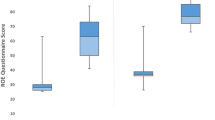Abstract
Objective
We aimed to investigate the relationship between the number of visits to different physicians and postoperative satisfaction in patients undergoing primary septorhinoplasty by using the ROE survey.
Methods
Patients for whom we performed septorhinoplasty in the last 3 years were examined. Patients who visited 3 different physicians (including us) before the surgery were allocated to group 1. Patients who visited ≥ 4 physicians comprised group 2. We randomized 50 patients in each group. Rhinoplasty outcome evaluation (ROE) was performed twice for the preoperative evaluation and to determine the satisfaction in postoperative 6th month.
Results
Preoperative and postoperative ROE values were significantly lower in group 2 (p < 0.001). ROE values after surgery were 82% in group 1 and 68.92% in group 2.
Conclusion
We think that it is more appropriate for patients who visit many surgeons to be evaluated more carefully and to be psychologically examined.
Level of Evidence IV
This journal requires that authors assign a level of evidence to each article. For a full description of these Evidence-Based Medicine ratings, please refer to the Table of Contents or the online Instructions to Authors www.springer.com/00266.


Similar content being viewed by others
References
Arima LM, Velasco LC, Tiago RS (2011) Crooked nose: outcome evaluations in rhinoplasty. Braz J Otorhinolaryngol 77:510–515
Herruer JM, Prins JB, van Heerbeek N et al (2018) Does self-consciousness of appearance influence postoperative satisfaction in rhinoplasty? J Plast Reconstr Aesthet Surg 71(1):79–84
Javanbakht M, Nazari A, Javanbakht A, Moghaddam L (2012) Body dysmorphic factors and mental health problems in people seeking rhinoplastic surgery. Acta Otorhinolaryngol Ital 32(1):37–40
Alsarraf R, Larrabee WF Jr, Anderson S et al (2001) Measuring cosmetic facial plastic surgery outcomes: A pilot study. Arch Facial Plast Surg 3(3):198–201
Çelik M, Altıntaş A (2019) The turkish version of the rhinoplasty outcomes evaluation questionnaire: validation and clinical application. Balkan Med J 36(2):129–133
Ercolani M, Baldaro B, Rossi N, Trombini G (1999) Five-year follow-up of cosmetic rhinoplasty. J Psychosom Res 47:28–86
Amodeo CA (2007) The central role of the nose in the face and the psyche: Review of the nose and the psyche. Aesth. Plast Surg 31:406–410
Sarwer DB (2002) Awareness and identification of body dysmorphic disorder by aesthetic surgeons: results of a survey of the American Society for Aesthetic Plastic Surgery members. Aesthet Surg J 22(06):531–535
Picavet VA, Prokopakis EP, Gabriels L, Jorissen M, Hellings PW (2011) High prevalence of body dysmorphic disorder symptoms in patients seeking rhinoplasty. Plast Reconstr Surg 128(2):509–517
Veale D, De Haro L, Lambrou C (2003) Cosmetic rhinoplasty in body dysmorphic disorder. Br J Plast Surg 56:546–551
Veale D, Bewley A (2015) Body dysmorphic disorder. BMJ 350:2278
Joseph J, Randhawa P, Hannan SA, et al. (2017) Body Dysmorphic Disorder in patients undergoing septorhinoplasty surgery. Should we be performing routine screening?. Clin Otolaryngol 42(3):508–513.
Adamson PA, Strecker HD (2002) Patient selection. Aesth Plast Surg 26(1):11
Sykes JM (2008) Patient selection in facial plastic surgery. Facial Plast Surg Clin North Am 16:173–176
Tardy ME, Toriumi DM (1993) Philosophy and principles of rhinoplasty. In: Cummings CW (ed) Otolaryngology: head and neck surgery, 2nd ed. Mosby, St.Louis, MO, pp 278–294
Correa AJ, Sykes JM, Russell Ries W (1999) Considerations before rhinoplasty. Otolaryngol Clin North Am 32:7–14
Knorr NJ (1972) Feminine loss of identity in rhinoplasty. Arch Otolaryngol 96:11–15
Rhee JS (2009) Measuring Outcomes in Nasal Surgery: Realities and Possibilities. Arch Facial Plast Surg 11(6):416–419
Pusic AL, Klassen AF, Scott AM, Cano SJ (2013) Development and psychometric evaluation of the FACE-Q satisfaction with appearance scale a new patient-reported outcome instrument for facial aesthetics patients. Clin Plastic Surg 40(2):249–260
Izu SC et al (2014) Validation of the rhinoplasty outcomes evaluation (ROE) questionnaire adapted to Brazilian Portuguese. Qual Life Res 23(3):953–958
Bulut OC, Plinkert PK, Wallner F, Baumann I (2016) Quality of life in functional rhinoplasty: rhinoplasty outcomes evaluation German version (ROE-D). Eur Arch Otorhinolaryngol 273:2569–2573
Acknowledgements
We would like to thank Asena Ayça Özdemir for her valuable help in the statistical analyses.
Author information
Authors and Affiliations
Corresponding author
Ethics declarations
Conflict of interest
The authors declare that they have no conflict of interest.
Ethical Approval
All procedures performed in this study involving human participants were conducted in accordance with the ethical standards of the institutional research committee and with the 1964 Helsinki Declaration and its later amendments comparable ethical standards. The study was approved by the institutional ethics committee. This article does not contain any studies with animals performed by any of the authors.
Informed Consent
Informed consent was obtained from all individual participants included in the study.
Additional information
Publisher's Note
Springer Nature remains neutral with regard to jurisdictional claims in published maps and institutional affiliations.
Rights and permissions
About this article
Cite this article
Erkan, Z.A., Erkan, S.O. The Importance of Multiple, Different Rhinoplasty Consultations in Patient Selection. Aesth Plast Surg 43, 1595–1600 (2019). https://doi.org/10.1007/s00266-019-01403-8
Received:
Accepted:
Published:
Issue Date:
DOI: https://doi.org/10.1007/s00266-019-01403-8




